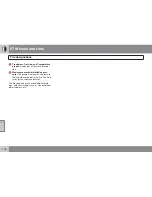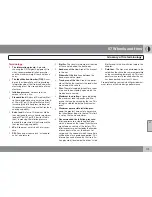
07 Wheels and tires
Tire Sealing System
07
190
7.
Remove the valve cap from the tire’s infla-
tion valve and screw the tire sealing sys-
tem’s hose connector onto the valve as
tightly as possible by hand.
8.
Connect the electrical wire to the nearest
12-volt socket in the vehicle.
9.
Start the vehicle’s engine.
10. Start the tire sealing system’s compressor
by pressing the on/off switch to position
I
.
WARNING
•
Never stand next to the tire being inflated
when the compressor is in operation.
•
If cracks, bubbles, etc. form on the tire,
switch off the compressor immediately.
•
If there is visible damage to the sidewall
or the rim, the tire cannot be repaired.
The vehicle should not be driven if this
occurs. Contact a towing service or
Volvo On Call Roadside Assistance if
applicable.
NOTE
The air pressure gauge will temporarily
show an increase in pressure to approxi-
mately 88 psi (6 bar) while the sealing com-
pound is being pumped into the tire. The
pressure should return to a normal level
after approximately 30 seconds.
11. Within seven minutes, inflate the tire to
between 22—44 psi (1.8—3.0 bar). Switch
off the compressor briefly to get a clear
reading from the pressure gauge. The
compressor should not be used for more
than 10 minutes at a time to avoid over-
heating.
CAUTION
The compressor should not be used for
more than 10 minutes at a time to avoid
overheating.
WARNING
If the pressure remains below 22 psi
(1.8 bar) after approximately seven minutes,
turn off the compressor. In this case, the
hole is too large to be sealed and the vehicle
should not be driven.
12. Switch off the compressor and disconnect
the electrical wire from the 12-volt socket.
13. Unscrew the hose from the tire’s inflation
valve and reinstall the valve cap.
14. Immediately drive the vehicle for approxi-
mately 2 miles (3 km) at a maximum speed
of 50 mph (80 km/h) to distribute the seal-
ing compound in the tire.
CAUTION
If your vehicle is equipped with the Tire
Pressure Monitoring System (TPMS), the
use of the sealing compound may lead to
incorrect tire pressure readings or in rare
cases, damage to the tire pressure sensor.
Use the tire sealing system to check and
adjust the damaged tire's inflation pressure.
NOTE
•
Safely stow the tire sealing system in a
convenient place as it will soon be used
again to check the tire’s inflation pres-
sure.
•
The empty bottle of sealing compound
cannot be removed from the bottle
holder. Consult a trained and qualified
Volvo service technician to have the
bottle removed and properly disposed
of.
Summary of Contents for 2010 C30
Page 1: ...VOLVO C30 Owner s manual Web Edition...
Page 2: ......
Page 8: ...Contents 8 12 12 Index Index 276...
Page 9: ...Contents 9...
Page 15: ...01 SAFETY...
Page 47: ...01 Safety 01 47...
Page 49: ...02 INSTRUMENTS AND CONTROLS...
Page 50: ...02 Instruments and controls Instrument overview 02 50 G019492...
Page 89: ...03 CLIMATE...
Page 101: ...04 INTERIOR...
Page 111: ...04 Interior Storage compartments 04 111...
Page 121: ...05 LOCKS AND ALARM...
Page 135: ...05 Locks and alarm 05 135...
Page 137: ...06 STARTING AND DRIVING...
Page 169: ...07 WHEELS AND TIRES...
Page 195: ...07 Wheels and tires 07 195...
Page 196: ...G020920 196 Washing and cleaning the car 198 Paint touch up 202...
Page 197: ...08 CAR CARE...
Page 203: ...08 Car care 08 203...
Page 205: ...09 MAINTENANCE AND SERVICING...
Page 235: ...10 AUDIO...
Page 259: ...10 Audio 10 259...
Page 261: ...11 SPECIFICATIONS...
Page 262: ...11 Specifications Label information 11 262...
Page 283: ......
Page 284: ...Kdakd 8Vg 8dgedgVi dc IE JH6 8VcVYV 6I Eg ciZY c HlZYZc iZWdg 8deng i Kdakd 8Vg 8dgedgVi dc...
















































